|
|
You are not currently logged in. Are you accessing the unsecure (http) portal? Click here to switch to the secure portal. |
Difference between revisions of "Gérard Thibault d'Anvers"
| (52 intermediate revisions by 2 users not shown) | |||
| Line 23: | Line 23: | ||
| period = | | period = | ||
| movement = [[La Verdadera Destreza]] | | movement = [[La Verdadera Destreza]] | ||
| − | | influences = {{plainlist | [[Jerónimo Sánchez de Carranza]] | [[Luis Pacheco de Narváez]] }} | + | | influences = {{plainlist |
| + | | [[Jerónimo Sánchez de Carranza]] | ||
| + | | [[Luis Pacheco de Narváez]] | ||
| + | }} | ||
| influenced = | | influenced = | ||
| Line 42: | Line 45: | ||
Thibault was born in or around 1574 in Antwerp, son of Hendrick Thibaut and Margaretha van Nispen.<ref name="Verwey, Herman Fontaine 1978 p.288">de la Verwey, Herman Fontaine. "Gerard Thibault and his Academie de l'Espée," Quaerendo VIII (1978) p.288</ref> Although his father used the surname "Thibaut," Gérard used the French form "Thibault."<ref name="Verwey, Herman Fontaine 1978 p.288"/> Hendrick Thibaut came from a well-known family in Ypres, living in Ghent and Antwerp before going into exile in the northern Netherlands.<ref name="Verwey, Herman Fontaine 1978 p.288"/> Henrick's eldest son, Christiaen, founded the noble family Thibaut van Aegtekerke.<ref>de la Verwey, Herman Fontaine. "Gerard Thibault and his Academie de l'Espée," Quaerendo VIII (1978) p.288-289</ref> | Thibault was born in or around 1574 in Antwerp, son of Hendrick Thibaut and Margaretha van Nispen.<ref name="Verwey, Herman Fontaine 1978 p.288">de la Verwey, Herman Fontaine. "Gerard Thibault and his Academie de l'Espée," Quaerendo VIII (1978) p.288</ref> Although his father used the surname "Thibaut," Gérard used the French form "Thibault."<ref name="Verwey, Herman Fontaine 1978 p.288"/> Hendrick Thibaut came from a well-known family in Ypres, living in Ghent and Antwerp before going into exile in the northern Netherlands.<ref name="Verwey, Herman Fontaine 1978 p.288"/> Henrick's eldest son, Christiaen, founded the noble family Thibaut van Aegtekerke.<ref>de la Verwey, Herman Fontaine. "Gerard Thibault and his Academie de l'Espée," Quaerendo VIII (1978) p.288-289</ref> | ||
| − | Thibault first studied | + | Thibault first studied fencing in Antwerp under Lambert van Someron, who taught between the years of 1564 and 1584.<ref name="Verwey, Herman Fontaine 1978 p.290">de la Verwey, Herman Fontaine. "Gerard Thibault and his Academie de l'Espée," Quaerendo VIII (1978) p.290</ref> In 1605, Thibault was a wool merchant in Sanlúcar de Barrameda, south of Seville on the Guadalquivir river, and the hometown of Jerónimo Sánchez de Carranza.<ref name="Verwey, Herman Fontaine 1978 p.289">de la Verwey, Herman Fontaine. "Gerard Thibault and his Academie de l'Espée," Quaerendo VIII (1978) p.289</ref> There, he took an interest in fencing, studying the Spanish rapier system of Destreza.<ref name="Verwey, Herman Fontaine 1978 p.289"/> |
Thibault left Spain to return to the Netherlands, and was in Amsterdam as early as 1610.<ref name="Verwey, Herman Fontaine 1978 p.289"/> In or around 1611, he presented his system to an assembly of Dutch masters at a competition in Rotterdam.<ref>de la Verwey, Herman Fontaine. "Gerard Thibault and his Academie de l'Espée," Quaerendo VIII (1978) pp.289-290</ref> Thibault won first prize, earning an invitation to the court of Prince Maurice of Nassau, where the Prince observed Thibault's system in a multi-day demonstration.<ref name="Verwey, Herman Fontaine 1978 p.290"/> | Thibault left Spain to return to the Netherlands, and was in Amsterdam as early as 1610.<ref name="Verwey, Herman Fontaine 1978 p.289"/> In or around 1611, he presented his system to an assembly of Dutch masters at a competition in Rotterdam.<ref>de la Verwey, Herman Fontaine. "Gerard Thibault and his Academie de l'Espée," Quaerendo VIII (1978) pp.289-290</ref> Thibault won first prize, earning an invitation to the court of Prince Maurice of Nassau, where the Prince observed Thibault's system in a multi-day demonstration.<ref name="Verwey, Herman Fontaine 1978 p.290"/> | ||
| Line 53: | Line 56: | ||
== Treatise == | == Treatise == | ||
| + | The ''[[Academie de l'Espée (Gérard Thibault d'Anvers)|Academie de l'Espée]]'' (1630) is presented in two books. Book 1 consists of a short introduction, populated with plates showing the coats of arms of several nobles who were prominent in and around the court of the low countries at the time he wrote this book, and then introduces training in the use of his system of swordplay. | ||
| + | |||
| + | Thibault, although he does not explain until Plate 8, uses the term ''estocade'' to describe a thrust to the near, right side, and the term ''imbrocade'' to describe a thrust to the far, left side, from the Italian terms ''stoccata'' and ''imbroccata''. English has a single term ''thrust'' to mean either, but did borrow the Italian term ''imbroccata'' to specifically refer to the latter type of thrust. | ||
| + | |||
| + | Plate I begins with a long philosophical discussion of his worldview. It is a good insight into the late Renaissance worldview relating mathematics and Christian religious beliefs to an idealized human figure. It then explains how to construct his <i>Mysterious Circle</i>. This includes a lengthy discussion of how the circle relates geometrically to the ideal body size, based on Vitruvius, and notes about how the lines and crossing points of the circle will be used. This is the basic reference diagram for the entire system. | ||
| + | It also includes explanations of how to measure for the correct sword size for any given person, and some explanation of why this is so, and some introductory explanation of appropriate ranges for swordplay. | ||
| + | |||
| + | Plate II compares his ideal body measurements against a figure by Albrecht Durer. Part 2 discusses his ideal sword scabbard and how to construct and wear it. | ||
| + | |||
| + | Plates III & IV deal with how to properly draw a sword and how to approach an adversary. | ||
| + | |||
| + | Plate V introduces his fighting system. First, how to deal with feints (typical of the schools of the time) and defend against typical thrusts. | ||
| + | |||
| + | Plate VI introduces several basic concepts. The importance of maintaining contact between swords, not typical of schools of the time, and the basic steps to close with and thrust into an opponent. The first steps show the attack as if he were to make no defense. Then he assumes the opponent will try to disrupt the attack, and discusses how to deal with interruptions if they occur at various points during the movement. | ||
| + | |||
| + | Plate VII introduces an opponent using circular disengagements and counterthrusts to disrupt an attack, and how to counter them. | ||
| + | |||
| + | Plate VIII introduces the imbroccata attack against the left side and exercises to counter them when they occur at various stages of the attack. | ||
| + | |||
| + | Plates IX & X introduces the idea of blade control and resistance using various degrees of force which can be applied against the blade to parry an attack. He defines several increasing degrees of pressure and introduces exercises to learn to distinguish them, and how to counter parries by force. His recommendation to pursue a course of study, rather than master all the lessons from Plate IX to XIII before begining to practice the exercise in Plate XV, where he introduces attacking to the right hand side, but for practical training, to pair up the lessons of attacks to the outside line with those to the inside line. That is, do the exercises from Plate IX then Plate XV, Plate X with Plate XVI, and so on, practising each in turn. This way, the student learns to fight to both left and right hand side while acquiring increasing skills and ability. | ||
| + | |||
| + | Plate XI continues the exploration of how to deal with different degrees of force against the blade. | ||
| + | |||
| + | Plate XII shows how to create an angle between blades to move in against the opponent | ||
| + | |||
| + | Book 2 lacks an explanation of the complex frontspiece, and was incomplete at the time of his death, but what he does have shows how to use his style against other systems and weapons then in use, including shields, longsword, and firearms. | ||
| + | |||
| + | The plates uploaded to WikTenauer are sufficient to follow the text, but if anyone wishes to see very high definition images, they can be found on [http://www.geheugenvannederland.nl/ www.geheugenvannederland.nl]. Search on Girard Thibault. | ||
| + | |||
| + | {{master begin | ||
| + | | title = Book 1 - Introduction. Arms of Patrons and supporters of Thibault | ||
| + | | width = 90em | ||
| + | }} | ||
| + | {| class="master" | ||
| + | ! Illustrations | ||
| + | ! Translation by <br/> [[user:Bruce Hearns|Bruce G. Hearns]] | ||
| + | ! Transcription by <br/>[[user:Bruce Hearns|Bruce G. Hearns]] | ||
| + | |||
| + | |- style="font-family: times, serif; vertical-align:top" | ||
| + | |[[File:Academie de l'Espée Title.jpg|200px]] | ||
| + | |||
| + | |'''''Academy of the Sword''''' by Girard Thibeault of Antwerp, wherein is demonstrated by means of mathematical rules, upon the foundation of the mysterious Circle, the Theory and Practise of the true and, until present, unknown secrets of the handling of arms both on foot and on horseback. | ||
| + | |||
| + | M.DC.XXXVIII (1628) | ||
| + | |||
| + | |Academie de L'ESPÉE de Girard Thibault d'Anvers ou ſe demonſtrent par <font style-"font-variant: small-caps"> Reigles mathematiques ſur le fondemont d'un Cercle mysterieux la theorie et pratique</font> des vrais et iuſq'a preſent incognus ſecrets du maniement DES ARMES a Pied et a Cheval. | ||
| + | |||
| + | M.DC.XXVIII | ||
| + | |||
| + | |- style="font-family: times, serif; vertical-align:top" | ||
| + | |[[File:Thibault L1 Intro 02.jpg|200px]] | ||
| + | |||
| + | |In tranquil reason, not impatient in his work, leads us courageously along his meandering path. | ||
| + | |||
| + | Gerard Thibault of Antwerp | ||
| + | |||
| + | Rejoice. Patience endures. | ||
| + | |||
| + | |TRANQVILLA RATIO, NEC SVI IMPATIENS LABOR, MODUM EVAGANTI PRÆSTRVIT FEROCIÆ. | ||
| + | |||
| + | Gerard Tibault d'Anvers | ||
| + | |||
| + | Gaudet Patientia duris | ||
| + | |||
| + | |- style="font-family: times, serif; vertical-align:top" | ||
| + | |[[File:Thibault L1 Intro 03.jpg|200px]] | ||
| + | |||
| + | |To the valliant heart, nothing is impossible. | ||
| + | Arms and sundry titles of [https://en.wikipedia.org/wiki/George_William,_Elector_of_Brandenburg George William] (1595 – 1640) of the House of Hohenzollern, Elector of Brandenburg and Duke of Prussia from 1619. | ||
| + | |||
| + | |Au coeur vaillant rien n'est impossible | ||
| + | |||
| + | Serenissimo Principi ac Domino Domino Georgio Guilermo Marchioni Brandenburgensi S. Romani imperii Archicamerario et Electori; Borussiæ, Iuliæ, Cliviæ, Montium Stetini, Pomeraniæ, Cassubiorum, Vandalorum et in Silesia Crosnæ, Carnovi, æ’que Duci Burggravio Norimbergensi Principi Rugiæ. Comiti Marchiæ, ac Ravensbergi. Dynatæ Ravenstein y, &c. | ||
| + | |||
| + | |- style="font-family: times, serif; vertical-align:top" | ||
| + | |||
| + | |[[File:Thibault L1 Intro 04.jpg|200px]] | ||
| + | |||
| + | |||
| + | | Work well without pause, and the hours pass quickly. | ||
| + | |||
| + | Arms and sundry titles of [https://en.wikipedia.org/wiki/John_Sigismund,_Elector_of_Brandenburg Johan Sigismund] (1572 – 1619), Elector of Brandenburg (1608 – 1619) of the House of Hohenzollern, Elector of Brandenburg from 1608 and Duke of Prussia, through his wife Anna, from 1618. | ||
| + | |||
| + | |Fais biens sans demeure, et peu de temps se passe l’heure | ||
| + | |||
| + | Serenissimo Principi ac Domino Do. Io. Achimo Sigismundo. Marchioni Brandenburgensi, Borussiæ, Iuliæ, Cliviæ, Montium Stetini, Pomeraniæ, Cassubiorum, Vandalorum, et in Silesia Crosnæ, Carnoviæ ‘que Ducter | ||
| + | |||
| + | |- style="font-family: times, serif; vertical-align:top" | ||
| + | |||
| + | |[[File:Thibault L1 Intro 05.jpg|200px]] | ||
| + | |||
| + | |||
| + | |Everything with God, Nothing without Reason. | ||
| + | Arms and title of [https://en.wikipedia.org/wiki/Christian,_Duke_of_Brunswick-Lüneburg Christian (the Elder)] (1566 - 1633), Duke of Brunswick and Lunenbourg. | ||
| + | |||
| + | |Tout Avec Dieu, Rien Sans Raison | ||
| + | |||
| + | Serenissimo Principi ac Domino Domino Christiano Duci Brunswicensi et Lunenburgensi | ||
| + | |||
| + | |- style="font-family: times, serif; vertical-align:top" | ||
| + | |||
| + | |[[File:Thibault L1 Intro 06.jpg|200px]] | ||
| + | |||
| + | |(Order of the Garter about the arms – Shame to him who evil thinks) | ||
| + | I maintain | ||
| + | |||
| + | Arms and titles of [https://en.wikipedia.org/wiki/Maurice,_Prince_of_Orange Maurice] of Nassau (1567 - 1625), who became Prince of Orange in 1618. | ||
| + | |||
| + | |(Order of the Garter about the arms – Honi soit qui mal y pense) | ||
| + | |||
| + | Ie Maintiendray | ||
| + | |||
| + | Ilustrissimo Heroi Muritio Principia Auraico, Comiti Nassoviæ, Cattimeliboci, Viandæ, Diestii, Lingæ, Mursiæ, Bueræ, Leerdami, &c. | ||
| + | Marchioni Veriæ, ac Frissinge Baroni Bredæ. Civitatis Graviæ, ac ditionis Cuyckiæ, Herrstas, Cranendonc, Warneston, Arlaii, Svti Viti. Daesburgi &c. Vicecomiti Hæreditario Antwerpiæ, et Bizantii &c. Gubernatoi Geldriæ, Hollandie,, Lelandiæ, Westfrisiæ Zutphaniæ, Ultraiecti, Transisalaniæ, Groninge et Omlandiæ; Summo earundem Provinciarum terra mario, misitiæ Duci | ||
| + | |- style="font-family: times, serif; vertical-align:top" | ||
| + | |||
| + | |[[File:Thibault L1 Intro 07.jpg|200px]] | ||
| + | |||
| + | |Of the homeland. With the homeland. | ||
| + | |||
| + | Arms and titles of [https://en.wikipedia.org/wiki/Frederick_Henry,_Prince_of_Orange Frederick Henry] (1584 - 1647), Prince of Orange (1625-1647) | ||
| + | |||
| + | |Patriæ. Patrique | ||
| + | |||
| + | Illustrissimo Principi ac Domino D. Frederico Henrico Principi Auraico. Comiti Nassoviæ, Dominio Geertrudis-bergæ, utriusque Swaluæ, Naeldwici. Marischalco Hæreditario Hollandiæ, Unitarum Provinciarum Equitum Præfecto Generali &c. | ||
| + | |||
| + | |- style="font-family: times, serif; vertical-align:top" | ||
| + | |||
| + | |[[File:Thibault L1 Intro 08.jpg|200px]] | ||
| + | |||
| + | |Constant | ||
| + | |||
| + | Arms & titles of [https://en.wikipedia.org/wiki/Ernest_Casimir_I,_Count_of_Nassau-Dietz Ernest Casimir] (1573-1632), Count of Nassau-Dietz (1606-1632) | ||
| + | |||
| + | |Constant | ||
| + | |||
| + | Illust[rissi]mo Principi Ernesto Casimiro Comiti Nassoviæ, Catimeliboci, Viandæ, Dies Rii; Domino Bilsteiniæ, Castrorum Unitarum Provenciarum Praefecto; Gubernatori Frisiæ &c. | ||
| + | |||
| + | |- style="font-family: times, serif; vertical-align:top" | ||
| + | |||
| + | |[[File:Thibault L1 Intro 09.jpg|200px]] | ||
| + | |||
| + | |God and all | ||
| + | |||
| + | Dedication and Arms of [https://en.wikipedia.org/wiki/Simon_VII,_Count_of_Lippe Simon VII] (1587-1627), Count of Lippe (1613-1627), and his brother [https://en.wikipedia.org/wiki/Otto,_Count_of_Lippe-Brake Otto] (1589 – 1657), Count of Lippe-Brake (1621-1657) | ||
| + | |||
| + | |Deo et Cunctis | ||
| + | |||
| + | Generosis vere’q Germanis Fratribus, Simoni et Otthoni, Comitibus et Nobisibus Dominis de Lippia | ||
| + | |||
| + | |- style="font-family: times, serif; vertical-align:top" | ||
| + | |||
| + | |[[File:Thibault L1 Intro 10.jpg|200px]] | ||
| + | |||
| + | |Nothing without God | ||
| + | |||
| + | Arms of Stephan Gans, [https://en.wikipedia.org/wiki/Gans_zu_Putlitz Baron Putlitz] | ||
| + | |||
| + | |Rien sans Dieu | ||
| + | |||
| + | Nobilissimo, Generosissimoq; Heroi Domino Stephano Gans, Libero Baroni PotlitzI, Nec non Wolffshagiæ, turmæ equestris sub ductu et moderamine Illustrissimi Principis Auraici præfecto | ||
| + | |||
| + | |- style="font-family: times, serif; vertical-align:top" | ||
| + | |||
| + | |[[File:Thibault L1 Intro 11.jpg|200px]] | ||
| + | |||
| + | |Arms of Louis XIII | ||
| + | |||
| + | [https://en.wikipedia.org/wiki/Louis_XIII_of_France Louis] de Bourbon, called the Just, by grace of God, most-Christian King of France and Navarre, thirteenth of this name. | ||
| + | 1628 | ||
| + | |||
| + | |LOVIS DE BOVRBON DICT LE IUSTE PAR LA GRACE DE DIEV TRES-CHESTIEN ROY DE FRANCE ET DE NAVARRE. TREIZIESME DE CE NOM | ||
| + | 1628 | ||
| + | |||
| + | |- style="font-family: times, serif; vertical-align:top" | ||
| + | |||
| + | |[[File:Thibault L1 Pg 01.jpg|200px]] | ||
| + | |||
| + | |To the most august, most high, most powerful, high, magnficent Emperors, Kings, Princes, Dukes, Counts, and all other Lords and noble Teachers and Amateurs, of the most noble science of handling Arms | ||
| + | |||
| + | |Aux tresauguste, treshaults, trespuissants, tresillustres, hautes, magnfiques, Empereur | ||
| + | |||
| + | Roys | ||
| + | |||
| + | Princes | ||
| + | |||
| + | Ducs | ||
| + | |||
| + | Comtes | ||
| + | |||
| + | et touts autres seigneurs et nobles Fauteurs & Amateurs de La tresnoble science de manier les armes | ||
| + | |||
| + | |- style="font-family: times, serif; vertical-align:top" | ||
| + | |||
| + | |[[File:Thibault L1 Pg 02.jpg|200px]] | ||
| + | |||
| + | | | ||
| + | |||
| + | |In nob. Et eximii viri <br> | ||
| + | D. GERARDI THIBAULTII <br> | ||
| + | Gladiatoriam artem, symbolo ac praemio <br> | ||
| + | ab illustrissimo principe <br> | ||
| + | Mavritio à Nassau, &c. Donatam. <br><br> | ||
| + | Inter ſe geminas ferro concurrere dextras, <br> | ||
| + | Fortuna ſuerat, nunc erit artis opus. <br> | ||
| + | Nam hoc Roma parens, quamuis Mauortia, non hoc <br> | ||
| + | Lećtorem docuit Gratia tota ſuum. <br> | ||
| + | Temporibus noſstris, ipſa ſe teſte, vetuſtas <br> | ||
| + | Vincitur, & faſſas dat ſupera manus; <br> | ||
| + | Artis inops: totus quam dum confiderat orbis, <br> | ||
| + | Tyronem unius ſe videt eſſe viri. <br> | ||
| + | Hanc rude donatus Veianius ineret arenam. <br> | ||
| + | Intrata eſt numquam dicet arena mibi. <br> | ||
| + | Trecius au debit cum Myrmillone ſub armis <br> | ||
| + | Stare, nec hic illi jam metuendus erit. <br> | ||
| + | Hanc Samnis teneat, teneat qui prouocat, artem; <br> | ||
| + | Ignauo neuter ſanguine tinget hamum. <br> | ||
| + | Hanc colit, hac noſstrum Thibautius imbuit auum, <br> | ||
| + | Hanc nondum genitis nobile donat opus. <br> | ||
| + | Nec negat hoc Martis ſoboles Naſſovius Heros, <br> | ||
| + | Et jam victori præmia certa dedit: <br> | ||
| + | Inſtrućtorque operis, plauſuque opibusque parenti <br> | ||
| + | Adfuit, & partem vindicat ipſe ſibi. <br> | ||
| + | Quælibet arguto peragenda eſt judice cauſa: <br> | ||
| + | Hac à non victo Pricipe palma datur. <br> | ||
| + | D. Heinsius | ||
| + | |||
| + | |- style="font-family: times, serif; vertical-align:top" | ||
| + | |||
| + | |rowspan="2"|[[File:Thibault L1 Pg 03.jpg|200px]] | ||
| + | |||
| + | |GRANT OF PRIVILEGE BY THE KING OF FRANCE | ||
| + | |||
| + | By grace and privilege of the King, it has been permitted and granted to Gerard Thibault native of Antwerp, to print, sell, and distribute the present book and figures, in such character and volume as to him seems fit, in all the Kingdoms, lands, and holdings of his Majesty during a period of nine years counting from the day he shall have it printed, with all protections from all persons of whatever quality and condition they may be, to sell and distribute the said book, in part or portion thereof, whether a lithograph, woodcut, etched plate, stolen or counterfeit, or to sell the said figures alone or with summary of what they represent, either separately or jointly, on pain of contravention of loss of goods and five thousand pounds fine, half applicable to his Majesty, and the other to the said Thibault; who, moreover carries full letters to this effect, given in Paris, the XXI Day of December, in the year of grace one thousand six hundred and twenty and in fourth of the reign of the said King. | ||
| + | |||
| + | Signed by the King in his Council and sealed with the great seal of his Majesty in yellow wax on a ribbon. | ||
| + | |||
| + | |EXTRAICT DU PRIVILEGE DU ROY DE FRANCE | ||
| + | |||
| + | Par grace & privilege du Roy, il a eſté permis & oćtroyé à Gerard Thibault natif d'Anvers, d'imprimer vendre & debiter le preſent livre & figures, en tel charaćter & volume que bon luy ſemblera, par tous les Royaumes pays terres & Seigneuries de ſa Majeſté, pandant le temps de neuf ans à compter du jour qu'il ſera achevé d'imprimer: avec deffences à toutes perſonnes de quelque qualité & condition qu'ils ſoyent, de vendre & debiter ledićt livre part ou portion d'iceluy, avec leſdites figures ſeuls ou ſans icelles, ſoit taille douce, de bois, d’eau forte, de le pocher ou contrefaire, ou vendres leſdites figures ſeules ou avec ſomaire de ce qu'elles repreſentent, ſoit ſeparemant ou conjoinćtment, ſur pene au contrevenant de perte des exemplaires, & de cincq mille livres d'amande; moitie applicable à ſa Majeſté, & l'autre audićt Thibault; comme plus a plein eſt porté aux lettres ſur ce obtenues, données à Paris le XXI. Jour de Decembre, l'an de grace mil ſix cent vengt, & du regne du dićt Seigneur le quatieſme. | ||
| + | |||
| + | ''Seignées par le Roy en ſon Conſeil Perrochet, & ſcellees du grand ſeau de ſa Maieſté en cire jaune à queue pendant.'' | ||
| + | |||
| + | |- style="font-family: times, serif; vertical-align:top" | ||
| + | |||
| + | |PRIVILEGE | ||
| + | |||
| + | The Estates General of the United Provinces of the Netherlands, have consented and granted, and do consent and grant to the named Gerald Thibault, that be during the time of next thirty years to come, alone in these united Lands, affiliated lands and towns, full rights and privileges that he may print, sell, and distribute this treatise, engravings, instructions, knowlege, & exercises entitled “Academie de GIRARD THIBAULT d'Anvers, ou ſe demonſtrent d'un cercle mysſterieus la theorie & praćticque des vrais, & juſtes à preſent ingcognus ſecrets du maniement de Armes à pied & à cheval.” | ||
| + | |||
| + | Forbidding one and all within the jursdiction of these lands, to offer for sale copies of the aforesaid book for the aforsaid time of thirty years, directly or indirectly, in whole, or in part either greater or lesser, neither the imprint, nor the engravings, nor the explanations of the engravings. | ||
| + | |||
| + | Upon pain of forfeture of all copies and payment of a fine of the sum of nine hundred guilders. | ||
| + | |||
| + | One third part thereof to be given to the officer who performed the arrest, the second third to the watchmen, and the remaining third to the aforesaid Girardo Thibault. | ||
| + | |||
| + | Given in Graven-Hague this fifth of June Sixteen-Twenty-Seven. | ||
| + | |||
| + | Gaspar van Vosgbergen. | ||
| + | |||
| + | By order of the President of the Estates-General. | ||
| + | |||
| + | I. van GOCH. | ||
| + | |||
| + | |PRIVILEGIE | ||
| + | |||
| + | ''De Staten Generael der Vereenighde Nederlanden, hebben gheconſenteert ende gheoćtroyeert, conſenteren ende oćtoyeren by deſen d'erfghanamen van Giraldo Thibault, dat ſy gheduerende den tijdt van dertich eerſt-ckomende Iaren, alleene in deſe vereenighde Landen, gheaſſocieerde Landtſchappen ende Steden, ſullen moghen Drucken, doen Drucken, ende uytgheven ſeeckere Wapen-kunſt, beſtaende in Figuren, met regulen, aenwijſinghen ende leer-ſstucken, gheinſituleert'' Academie de GIRARD THIBAULT d'Anvers, ou ſe demonſtrent d'un cercle mysſterieus la theorie & praćticque des vrais, & juſtes à preſent ingcognus ſecrets du maniement de Armes à pied & à cheval. ''Verbiedende allen ende een yeghelijck Ingheſetenen van deſe Landen, de voorſchreven Wapen-konſte binnen den voorſchreven tijdt van dertich Iaren, direćtelijck ofte indirećtelijck, in't geheel, ofte ten deele, in't groot oſte in't kleyne, na te Drucken, ende uyt te gheven, oſte elders na ghedruct, hier te Lande te brenghen om verkoſt te werden, by verbeurte van alle de na-ghedruckte exemplaren, ende daer-en-boven van de ſomme van neghen hondert guldens; 'tappliceren een derdendeel daer van ten behoeve van Officier die de calangie doen ſal, het tweede derdendeel ten behoeve van de armen, ende het reſterend derdendeel ten behove van de voorſchreven erfghenamen van Girardo Thibault. Ghedaen in s'Graven-Haghe op den vijfden Iunij ſeſthein-hondert ſeven en twintich.'' | ||
| + | |||
| + | Gaſpar van Vosberghen Vt. | ||
| + | |||
| + | ''Ter ordonnantie van de Hooch-ghemelte Heeren Staten Generael.'' | ||
| + | |||
| + | I. van GOCH | ||
| + | |||
| + | |- style="font-family: times, serif; vertical-align:top; font-variant:small-caps" | ||
| + | |rowspan="2"|[[file:Thibault L1 Pg 04.jpg|200px]] | ||
| + | |'''NOTICE CONCERNING''' | ||
| + | |||
| + | the figures of this book. | ||
| + | |||
| + | |'''AVERTISSEMENT SVR LA CONSI-''' | ||
| + | |||
| + | deration des figures de ce livre. | ||
| + | |||
| + | |- style="font-family: times, serif; vertical-align:top" | ||
| + | | Because the reader shall find it strange that many of the images are not placed upon the ground, but are above or below the horizon, we think it best they be conceived of as paintings upon the walls; this being because of the unequal circles above the horizon compared to the ground, and for more convenient representation of the doctrine, & for easier intelligbility in a manner which does not extend perspectives. Thus in Plate 3, high on both sides, we see 4 men painted on the walls, & in Plate 5 there are four pieces in the form of paintings in the middle of the masonry wall each with its own appropriately-sized circle. In Plates 6, 16, 21, 22, 25, & 28 we find painted canvasses & murals on the sides, and on the lower parts of the walls. In Plates 7 & 27 we understand they are made in the form of charts. In Plate 19, a tapestry hangs in the middle, in which the doctrines are embroidered. The Plates 5, 8, 14, 17, 18, 20, 22, 25, 26, 27, 28, & 29 likewise have painted walls, but the most important parts are shown alive on the ground or as painting on the wall base, because we have put there the means to see how the position of the swords relates to the lines of the Circle in the form of shadows on the lower line or base. We can see the positions of the blades, on the ground of the circle, by which means the capability to work out the movements of the swords the figures have in their hands becomes quite easy. | ||
| + | | Pource que le ſpećtateur trouveroit eſtrange, que pluſieurs Images ne ſont fixement poſées ſur le fondement, taut au deſſus qu'au deſſoubs de l'Horiſon: nous avons touvé bon de l'advertir, qu'il les faut concevoir comme eſtant deſpeintes aux murailles; cela eſtant fait à cauſe des Cercles inegaux tant au deſſus de l'Horiſon que ſur le plan, pour la repreſentation plus commode de la doćtrine, & pour l'intelligence plus facile du commun qui n'entend les perſpećtives: ainſi au Tableau 3. au deſſus d'un & d'autre coſté ſont deſpeints 4. hommes aux parois, & en la Table 5. il y à quatre pieces en forme de peinture au millieu de la muraille ou maſſonerie, deſquels Cercles chaſcun ſuſſit pour ſoy, & es Tables 6. 16. 21. 22. 25. & 28. au millieu des toilles peinturées, & au coſtez ſont deſpeintes à la paroy, es Tables 7. & 27. faut entendre que cela eſt fait en forme de chartes, & en la Table 19. un tapi tendu ou pendu au millieu, dans leſquel les doćtrines ſont tiſſues, & es Tables 5. 8. 14. 17. 18. 20. 22. 25. 26. 27. 28. 29. de meſme deſpeint aux murailles, mais les premieres pieces ſe demonſtrent plus vivement ſur le fond ou baſe que les autres, car la ſe voit la façon des accords des eſpées & leur operation par les lignes du Cercle; pour ce que en forme d'Eſquierre de la ligne Inferieure ou baſe, on trouve un accord des lames, fait au fond ou Cercle, par lequel le jugement des operations mouvantes des eſpées que les figures tiennent en main, eſt rendu tres-facile. | ||
| + | |||
| + | |} | ||
| + | {{master end}} | ||
| + | |||
| + | {{master begin | ||
| + | | title = Book 1 - Tableau / Plates I - XI | ||
| + | | width = 60em | ||
| + | }} | ||
| + | {{main|Gérard Thibault d'Anvers/Plates 1-11}} | ||
| + | {{master end}} | ||
| + | |||
| + | {{master begin | ||
| + | | title = Book 1 - Tableau / Plates XII - XXII | ||
| + | | width = 60em | ||
| + | }} | ||
| + | {{main|Gérard Thibault d'Anvers/Plates 12-22}} | ||
| + | {{master end}} | ||
| + | |||
| + | {{master begin | ||
| + | | title = Book 1 - Tableaux / Plates XII - XXII | ||
| + | | width = 60em | ||
| + | }} | ||
| + | {{main|Gérard Thibault d'Anvers/Plates 23-33}} | ||
| + | {{master end}} | ||
| + | |||
| + | {{master begin | ||
| + | | title = Copyright and License Summary | ||
| + | | width = 100% | ||
| + | }} | ||
| + | For further information, including transcription and translation notes, see the [[Talk:{{PAGENAME}}|discussion page]]. | ||
| + | |||
| + | <section begin="sourcebox"/>{{sourcebox header}} | ||
| + | {{sourcebox | ||
| + | | work = Images | ||
| + | | authors = courtesy of Reinier van Noort | ||
| + | | source link = http://www.bruchius.com/img/Thibault.zip | ||
| + | | source title= Thibault.zip | ||
| + | | license = noncommercial | ||
| + | }} | ||
| + | {{sourcebox | ||
| + | | work = Translation | ||
| + | | authors = [[translator::Bruce G. Hearns]] | ||
| + | | source link = | ||
| + | | source title= Wiktenauer | ||
| + | | license = noncommercial | ||
| + | }} | ||
| + | {{sourcebox | ||
| + | | work = Transcription | ||
| + | | authors = [[User:Bruce Hearns|Bruce G. Hearns]] | ||
| + | | source link = | ||
| + | | source title= Wiktenauer | ||
| + | | license = noncommercial | ||
| + | }} | ||
| + | {{sourcebox footer}}<section end="sourcebox"/> | ||
| + | {{master end}} | ||
== Additional Resources == | == Additional Resources == | ||
| − | * | + | * Howden, Matthew. "[http://matthewhowden.wordpress.com/comparison-of-thibaults-circle-and-the-leiden-circle/ Comparison of Thibault’s Circle and the Leiden Circle]". ''Sworded Contemplations''. April, 2008. Retrieved 08 February 2015. |
| + | {{bibliography}} | ||
== References == | == References == | ||
| − | {{reflist | + | {{reflist}} |
{{DEFAULTSORT:Thibault d'Anvers, Gérard}} | {{DEFAULTSORT:Thibault d'Anvers, Gérard}} | ||
__FORCETOC__ | __FORCETOC__ | ||
| Line 74: | Line 419: | ||
[[Category:Rapier]] | [[Category:Rapier]] | ||
| + | |||
| + | [[category:old format]] | ||
Latest revision as of 21:12, 15 June 2025
| Gérard Thibault d'Anvers | |
|---|---|
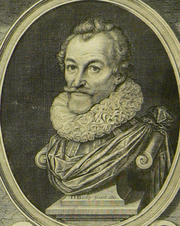 | |
| Born | 1574 |
| Died | 1629 |
| Occupation | Fencing master |
| Nationality | Dutch |
| Movement | La Verdadera Destreza |
| Influences | |
| Genres | Fencing manual |
| Language | French |
| Notable work(s) | Academie de l'Espée (1630) |
Gérard Thibault d'Anvers (ca. 1574–1629)[1] was a 17th century Dutch fencing master and author of the 1628 rapier manual Academie de l'Espée, one of the most detailed and elaborate sources ever written on fencing. Details about Thibault's life are sparse and what we know is based on his book and his album amicorum.[2] The latter contains handwritten notes and celebratory poems from Thibault's friends, relatives, pupils, and colleagues, included among whom are several contemporary fencing masters.[3]
Thibault was born in or around 1574 in Antwerp, son of Hendrick Thibaut and Margaretha van Nispen.[4] Although his father used the surname "Thibaut," Gérard used the French form "Thibault."[4] Hendrick Thibaut came from a well-known family in Ypres, living in Ghent and Antwerp before going into exile in the northern Netherlands.[4] Henrick's eldest son, Christiaen, founded the noble family Thibaut van Aegtekerke.[5]
Thibault first studied fencing in Antwerp under Lambert van Someron, who taught between the years of 1564 and 1584.[6] In 1605, Thibault was a wool merchant in Sanlúcar de Barrameda, south of Seville on the Guadalquivir river, and the hometown of Jerónimo Sánchez de Carranza.[2] There, he took an interest in fencing, studying the Spanish rapier system of Destreza.[2]
Thibault left Spain to return to the Netherlands, and was in Amsterdam as early as 1610.[2] In or around 1611, he presented his system to an assembly of Dutch masters at a competition in Rotterdam.[7] Thibault won first prize, earning an invitation to the court of Prince Maurice of Nassau, where the Prince observed Thibault's system in a multi-day demonstration.[6]
Although initially met with skepticism, Thibault convinced his fellow Dutch fencing masters, including Johannes Damius of Haarlem, Dirck van Stervergen of Leiden, Cornelis Cornelisz van Heusden of Amsterdam, and Thibault's former teacher Lambert von Someron.[6] In 1615, Thibault was invited to the court at Cleves and left Amsterdam, where he once again demonstrated his system successfully.[8] Over the next several years, Thibault traveled from Cleves, Amsterdam, to Spain, back to Amsterdam, and finally to Leiden in 1622.[9] There, Thibault studied mathematics at Leiden University.[10] It is unclear whether Thibault taught his system at the university.[10] It is during his time in Leiden that Thibault likely began working on Academie de l'Espée and employed a team of sixteen master engravers.[11]
Thibault died in 1629, a year before his masterpiece was finally published (despite the date on the title page of 1628, it was not published until 1630).[12]
Contents
Treatise
The Academie de l'Espée (1630) is presented in two books. Book 1 consists of a short introduction, populated with plates showing the coats of arms of several nobles who were prominent in and around the court of the low countries at the time he wrote this book, and then introduces training in the use of his system of swordplay.
Thibault, although he does not explain until Plate 8, uses the term estocade to describe a thrust to the near, right side, and the term imbrocade to describe a thrust to the far, left side, from the Italian terms stoccata and imbroccata. English has a single term thrust to mean either, but did borrow the Italian term imbroccata to specifically refer to the latter type of thrust.
Plate I begins with a long philosophical discussion of his worldview. It is a good insight into the late Renaissance worldview relating mathematics and Christian religious beliefs to an idealized human figure. It then explains how to construct his Mysterious Circle. This includes a lengthy discussion of how the circle relates geometrically to the ideal body size, based on Vitruvius, and notes about how the lines and crossing points of the circle will be used. This is the basic reference diagram for the entire system. It also includes explanations of how to measure for the correct sword size for any given person, and some explanation of why this is so, and some introductory explanation of appropriate ranges for swordplay.
Plate II compares his ideal body measurements against a figure by Albrecht Durer. Part 2 discusses his ideal sword scabbard and how to construct and wear it.
Plates III & IV deal with how to properly draw a sword and how to approach an adversary.
Plate V introduces his fighting system. First, how to deal with feints (typical of the schools of the time) and defend against typical thrusts.
Plate VI introduces several basic concepts. The importance of maintaining contact between swords, not typical of schools of the time, and the basic steps to close with and thrust into an opponent. The first steps show the attack as if he were to make no defense. Then he assumes the opponent will try to disrupt the attack, and discusses how to deal with interruptions if they occur at various points during the movement.
Plate VII introduces an opponent using circular disengagements and counterthrusts to disrupt an attack, and how to counter them.
Plate VIII introduces the imbroccata attack against the left side and exercises to counter them when they occur at various stages of the attack.
Plates IX & X introduces the idea of blade control and resistance using various degrees of force which can be applied against the blade to parry an attack. He defines several increasing degrees of pressure and introduces exercises to learn to distinguish them, and how to counter parries by force. His recommendation to pursue a course of study, rather than master all the lessons from Plate IX to XIII before begining to practice the exercise in Plate XV, where he introduces attacking to the right hand side, but for practical training, to pair up the lessons of attacks to the outside line with those to the inside line. That is, do the exercises from Plate IX then Plate XV, Plate X with Plate XVI, and so on, practising each in turn. This way, the student learns to fight to both left and right hand side while acquiring increasing skills and ability.
Plate XI continues the exploration of how to deal with different degrees of force against the blade.
Plate XII shows how to create an angle between blades to move in against the opponent
Book 2 lacks an explanation of the complex frontspiece, and was incomplete at the time of his death, but what he does have shows how to use his style against other systems and weapons then in use, including shields, longsword, and firearms.
The plates uploaded to WikTenauer are sufficient to follow the text, but if anyone wishes to see very high definition images, they can be found on www.geheugenvannederland.nl. Search on Girard Thibault.
| Illustrations | Translation by Bruce G. Hearns |
Transcription by Bruce G. Hearns |
|---|---|---|
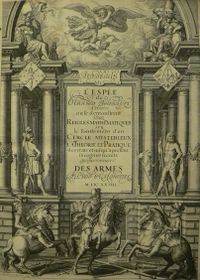
|
Academy of the Sword by Girard Thibeault of Antwerp, wherein is demonstrated by means of mathematical rules, upon the foundation of the mysterious Circle, the Theory and Practise of the true and, until present, unknown secrets of the handling of arms both on foot and on horseback.
M.DC.XXXVIII (1628) |
Academie de L'ESPÉE de Girard Thibault d'Anvers ou ſe demonſtrent par Reigles mathematiques ſur le fondemont d'un Cercle mysterieux la theorie et pratique des vrais et iuſq'a preſent incognus ſecrets du maniement DES ARMES a Pied et a Cheval.
M.DC.XXVIII |
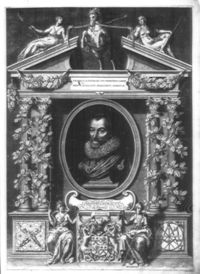
|
In tranquil reason, not impatient in his work, leads us courageously along his meandering path.
Gerard Thibault of Antwerp Rejoice. Patience endures. |
TRANQVILLA RATIO, NEC SVI IMPATIENS LABOR, MODUM EVAGANTI PRÆSTRVIT FEROCIÆ.
Gerard Tibault d'Anvers Gaudet Patientia duris |
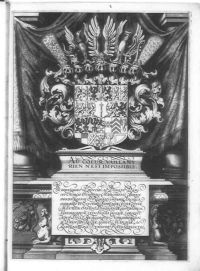
|
To the valliant heart, nothing is impossible.
Arms and sundry titles of George William (1595 – 1640) of the House of Hohenzollern, Elector of Brandenburg and Duke of Prussia from 1619. |
Au coeur vaillant rien n'est impossible
Serenissimo Principi ac Domino Domino Georgio Guilermo Marchioni Brandenburgensi S. Romani imperii Archicamerario et Electori; Borussiæ, Iuliæ, Cliviæ, Montium Stetini, Pomeraniæ, Cassubiorum, Vandalorum et in Silesia Crosnæ, Carnovi, æ’que Duci Burggravio Norimbergensi Principi Rugiæ. Comiti Marchiæ, ac Ravensbergi. Dynatæ Ravenstein y, &c. |
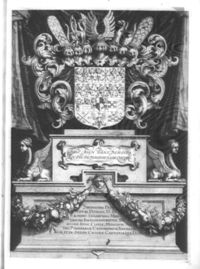
|
Work well without pause, and the hours pass quickly.
Arms and sundry titles of Johan Sigismund (1572 – 1619), Elector of Brandenburg (1608 – 1619) of the House of Hohenzollern, Elector of Brandenburg from 1608 and Duke of Prussia, through his wife Anna, from 1618. |
Fais biens sans demeure, et peu de temps se passe l’heure
Serenissimo Principi ac Domino Do. Io. Achimo Sigismundo. Marchioni Brandenburgensi, Borussiæ, Iuliæ, Cliviæ, Montium Stetini, Pomeraniæ, Cassubiorum, Vandalorum, et in Silesia Crosnæ, Carnoviæ ‘que Ducter |
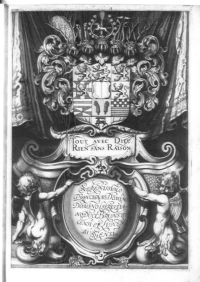
|
Everything with God, Nothing without Reason.
Arms and title of Christian (the Elder) (1566 - 1633), Duke of Brunswick and Lunenbourg. |
Tout Avec Dieu, Rien Sans Raison
Serenissimo Principi ac Domino Domino Christiano Duci Brunswicensi et Lunenburgensi |
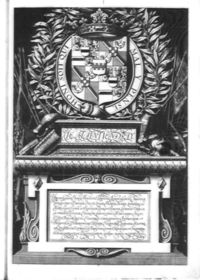
|
(Order of the Garter about the arms – Shame to him who evil thinks)
I maintain Arms and titles of Maurice of Nassau (1567 - 1625), who became Prince of Orange in 1618. |
(Order of the Garter about the arms – Honi soit qui mal y pense)
Ie Maintiendray Ilustrissimo Heroi Muritio Principia Auraico, Comiti Nassoviæ, Cattimeliboci, Viandæ, Diestii, Lingæ, Mursiæ, Bueræ, Leerdami, &c. Marchioni Veriæ, ac Frissinge Baroni Bredæ. Civitatis Graviæ, ac ditionis Cuyckiæ, Herrstas, Cranendonc, Warneston, Arlaii, Svti Viti. Daesburgi &c. Vicecomiti Hæreditario Antwerpiæ, et Bizantii &c. Gubernatoi Geldriæ, Hollandie,, Lelandiæ, Westfrisiæ Zutphaniæ, Ultraiecti, Transisalaniæ, Groninge et Omlandiæ; Summo earundem Provinciarum terra mario, misitiæ Duci |
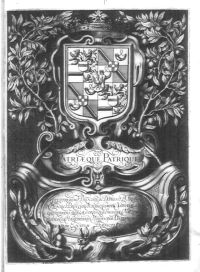
|
Of the homeland. With the homeland.
Arms and titles of Frederick Henry (1584 - 1647), Prince of Orange (1625-1647) |
Patriæ. Patrique
Illustrissimo Principi ac Domino D. Frederico Henrico Principi Auraico. Comiti Nassoviæ, Dominio Geertrudis-bergæ, utriusque Swaluæ, Naeldwici. Marischalco Hæreditario Hollandiæ, Unitarum Provinciarum Equitum Præfecto Generali &c. |
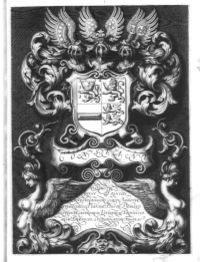
|
Constant
Arms & titles of Ernest Casimir (1573-1632), Count of Nassau-Dietz (1606-1632) |
Constant
Illust[rissi]mo Principi Ernesto Casimiro Comiti Nassoviæ, Catimeliboci, Viandæ, Dies Rii; Domino Bilsteiniæ, Castrorum Unitarum Provenciarum Praefecto; Gubernatori Frisiæ &c. |
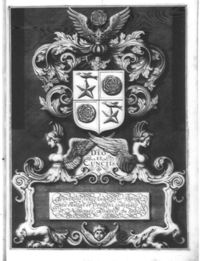
|
God and all
Dedication and Arms of Simon VII (1587-1627), Count of Lippe (1613-1627), and his brother Otto (1589 – 1657), Count of Lippe-Brake (1621-1657) |
Deo et Cunctis
Generosis vere’q Germanis Fratribus, Simoni et Otthoni, Comitibus et Nobisibus Dominis de Lippia |
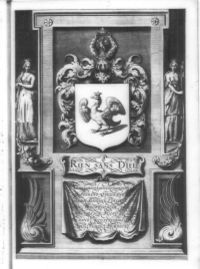
|
Nothing without God
Arms of Stephan Gans, Baron Putlitz |
Rien sans Dieu
Nobilissimo, Generosissimoq; Heroi Domino Stephano Gans, Libero Baroni PotlitzI, Nec non Wolffshagiæ, turmæ equestris sub ductu et moderamine Illustrissimi Principis Auraici præfecto |
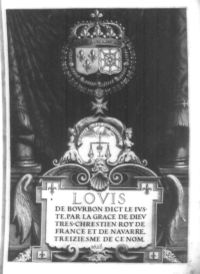
|
Arms of Louis XIII
Louis de Bourbon, called the Just, by grace of God, most-Christian King of France and Navarre, thirteenth of this name. 1628 |
LOVIS DE BOVRBON DICT LE IUSTE PAR LA GRACE DE DIEV TRES-CHESTIEN ROY DE FRANCE ET DE NAVARRE. TREIZIESME DE CE NOM
1628 |
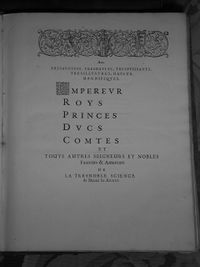
|
To the most august, most high, most powerful, high, magnficent Emperors, Kings, Princes, Dukes, Counts, and all other Lords and noble Teachers and Amateurs, of the most noble science of handling Arms | Aux tresauguste, treshaults, trespuissants, tresillustres, hautes, magnfiques, Empereur
Roys Princes Ducs Comtes et touts autres seigneurs et nobles Fauteurs & Amateurs de La tresnoble science de manier les armes |
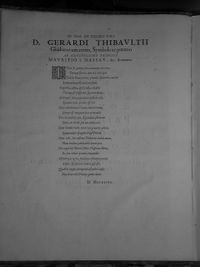
|
In nob. Et eximii viri D. GERARDI THIBAULTII | |
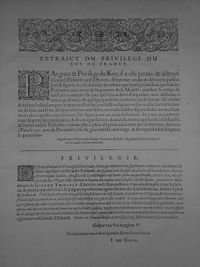
|
GRANT OF PRIVILEGE BY THE KING OF FRANCE
By grace and privilege of the King, it has been permitted and granted to Gerard Thibault native of Antwerp, to print, sell, and distribute the present book and figures, in such character and volume as to him seems fit, in all the Kingdoms, lands, and holdings of his Majesty during a period of nine years counting from the day he shall have it printed, with all protections from all persons of whatever quality and condition they may be, to sell and distribute the said book, in part or portion thereof, whether a lithograph, woodcut, etched plate, stolen or counterfeit, or to sell the said figures alone or with summary of what they represent, either separately or jointly, on pain of contravention of loss of goods and five thousand pounds fine, half applicable to his Majesty, and the other to the said Thibault; who, moreover carries full letters to this effect, given in Paris, the XXI Day of December, in the year of grace one thousand six hundred and twenty and in fourth of the reign of the said King. Signed by the King in his Council and sealed with the great seal of his Majesty in yellow wax on a ribbon. |
EXTRAICT DU PRIVILEGE DU ROY DE FRANCE
Par grace & privilege du Roy, il a eſté permis & oćtroyé à Gerard Thibault natif d'Anvers, d'imprimer vendre & debiter le preſent livre & figures, en tel charaćter & volume que bon luy ſemblera, par tous les Royaumes pays terres & Seigneuries de ſa Majeſté, pandant le temps de neuf ans à compter du jour qu'il ſera achevé d'imprimer: avec deffences à toutes perſonnes de quelque qualité & condition qu'ils ſoyent, de vendre & debiter ledićt livre part ou portion d'iceluy, avec leſdites figures ſeuls ou ſans icelles, ſoit taille douce, de bois, d’eau forte, de le pocher ou contrefaire, ou vendres leſdites figures ſeules ou avec ſomaire de ce qu'elles repreſentent, ſoit ſeparemant ou conjoinćtment, ſur pene au contrevenant de perte des exemplaires, & de cincq mille livres d'amande; moitie applicable à ſa Majeſté, & l'autre audićt Thibault; comme plus a plein eſt porté aux lettres ſur ce obtenues, données à Paris le XXI. Jour de Decembre, l'an de grace mil ſix cent vengt, & du regne du dićt Seigneur le quatieſme. Seignées par le Roy en ſon Conſeil Perrochet, & ſcellees du grand ſeau de ſa Maieſté en cire jaune à queue pendant. |
| PRIVILEGE
The Estates General of the United Provinces of the Netherlands, have consented and granted, and do consent and grant to the named Gerald Thibault, that be during the time of next thirty years to come, alone in these united Lands, affiliated lands and towns, full rights and privileges that he may print, sell, and distribute this treatise, engravings, instructions, knowlege, & exercises entitled “Academie de GIRARD THIBAULT d'Anvers, ou ſe demonſtrent d'un cercle mysſterieus la theorie & praćticque des vrais, & juſtes à preſent ingcognus ſecrets du maniement de Armes à pied & à cheval.” Forbidding one and all within the jursdiction of these lands, to offer for sale copies of the aforesaid book for the aforsaid time of thirty years, directly or indirectly, in whole, or in part either greater or lesser, neither the imprint, nor the engravings, nor the explanations of the engravings. Upon pain of forfeture of all copies and payment of a fine of the sum of nine hundred guilders. One third part thereof to be given to the officer who performed the arrest, the second third to the watchmen, and the remaining third to the aforesaid Girardo Thibault. Given in Graven-Hague this fifth of June Sixteen-Twenty-Seven. Gaspar van Vosgbergen. By order of the President of the Estates-General. I. van GOCH. |
PRIVILEGIE
De Staten Generael der Vereenighde Nederlanden, hebben gheconſenteert ende gheoćtroyeert, conſenteren ende oćtoyeren by deſen d'erfghanamen van Giraldo Thibault, dat ſy gheduerende den tijdt van dertich eerſt-ckomende Iaren, alleene in deſe vereenighde Landen, gheaſſocieerde Landtſchappen ende Steden, ſullen moghen Drucken, doen Drucken, ende uytgheven ſeeckere Wapen-kunſt, beſtaende in Figuren, met regulen, aenwijſinghen ende leer-ſstucken, gheinſituleert Academie de GIRARD THIBAULT d'Anvers, ou ſe demonſtrent d'un cercle mysſterieus la theorie & praćticque des vrais, & juſtes à preſent ingcognus ſecrets du maniement de Armes à pied & à cheval. Verbiedende allen ende een yeghelijck Ingheſetenen van deſe Landen, de voorſchreven Wapen-konſte binnen den voorſchreven tijdt van dertich Iaren, direćtelijck ofte indirećtelijck, in't geheel, ofte ten deele, in't groot oſte in't kleyne, na te Drucken, ende uyt te gheven, oſte elders na ghedruct, hier te Lande te brenghen om verkoſt te werden, by verbeurte van alle de na-ghedruckte exemplaren, ende daer-en-boven van de ſomme van neghen hondert guldens; 'tappliceren een derdendeel daer van ten behoeve van Officier die de calangie doen ſal, het tweede derdendeel ten behoeve van de armen, ende het reſterend derdendeel ten behove van de voorſchreven erfghenamen van Girardo Thibault. Ghedaen in s'Graven-Haghe op den vijfden Iunij ſeſthein-hondert ſeven en twintich. Gaſpar van Vosberghen Vt. Ter ordonnantie van de Hooch-ghemelte Heeren Staten Generael. I. van GOCH | |
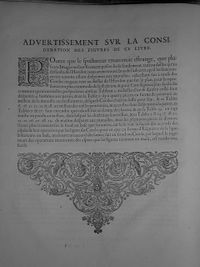
|
NOTICE CONCERNING
the figures of this book. |
AVERTISSEMENT SVR LA CONSI-
deration des figures de ce livre. |
| Because the reader shall find it strange that many of the images are not placed upon the ground, but are above or below the horizon, we think it best they be conceived of as paintings upon the walls; this being because of the unequal circles above the horizon compared to the ground, and for more convenient representation of the doctrine, & for easier intelligbility in a manner which does not extend perspectives. Thus in Plate 3, high on both sides, we see 4 men painted on the walls, & in Plate 5 there are four pieces in the form of paintings in the middle of the masonry wall each with its own appropriately-sized circle. In Plates 6, 16, 21, 22, 25, & 28 we find painted canvasses & murals on the sides, and on the lower parts of the walls. In Plates 7 & 27 we understand they are made in the form of charts. In Plate 19, a tapestry hangs in the middle, in which the doctrines are embroidered. The Plates 5, 8, 14, 17, 18, 20, 22, 25, 26, 27, 28, & 29 likewise have painted walls, but the most important parts are shown alive on the ground or as painting on the wall base, because we have put there the means to see how the position of the swords relates to the lines of the Circle in the form of shadows on the lower line or base. We can see the positions of the blades, on the ground of the circle, by which means the capability to work out the movements of the swords the figures have in their hands becomes quite easy. | Pource que le ſpećtateur trouveroit eſtrange, que pluſieurs Images ne ſont fixement poſées ſur le fondement, taut au deſſus qu'au deſſoubs de l'Horiſon: nous avons touvé bon de l'advertir, qu'il les faut concevoir comme eſtant deſpeintes aux murailles; cela eſtant fait à cauſe des Cercles inegaux tant au deſſus de l'Horiſon que ſur le plan, pour la repreſentation plus commode de la doćtrine, & pour l'intelligence plus facile du commun qui n'entend les perſpećtives: ainſi au Tableau 3. au deſſus d'un & d'autre coſté ſont deſpeints 4. hommes aux parois, & en la Table 5. il y à quatre pieces en forme de peinture au millieu de la muraille ou maſſonerie, deſquels Cercles chaſcun ſuſſit pour ſoy, & es Tables 6. 16. 21. 22. 25. & 28. au millieu des toilles peinturées, & au coſtez ſont deſpeintes à la paroy, es Tables 7. & 27. faut entendre que cela eſt fait en forme de chartes, & en la Table 19. un tapi tendu ou pendu au millieu, dans leſquel les doćtrines ſont tiſſues, & es Tables 5. 8. 14. 17. 18. 20. 22. 25. 26. 27. 28. 29. de meſme deſpeint aux murailles, mais les premieres pieces ſe demonſtrent plus vivement ſur le fond ou baſe que les autres, car la ſe voit la façon des accords des eſpées & leur operation par les lignes du Cercle; pour ce que en forme d'Eſquierre de la ligne Inferieure ou baſe, on trouve un accord des lames, fait au fond ou Cercle, par lequel le jugement des operations mouvantes des eſpées que les figures tiennent en main, eſt rendu tres-facile. |
For further information, including transcription and translation notes, see the discussion page.
| Work | Author(s) | Source | License |
|---|---|---|---|
| Images | courtesy of Reinier van Noort | Thibault.zip | |
| Translation | Bruce G. Hearns | Wiktenauer | |
| Transcription | Bruce G. Hearns | Wiktenauer |
Additional Resources
- Howden, Matthew. "Comparison of Thibault’s Circle and the Leiden Circle". Sworded Contemplations. April, 2008. Retrieved 08 February 2015.
The following is a list of publications containing scans, transcriptions, and translations relevant to this article, as well as published peer-reviewed research.
- Fontaine Verwey, Herman de la (1978). "Gerard Thibault and his Academie de l'Espée." Quaerendo 8(4): 283-319. doi:10.1163/157006978X00188.
- Majár, János; Zoltán Várhelyi (2014). "Thibault and Science I. Measure, Distances and Proportions in the Circle." Acta Periodica Duellatorum 2(1): 67-104. doi:10.1515/apd-2015-0014.
- Pascha, Johann Georg; Heinrich von und zum Velde (2018). Proper Description of Thrust-Fencing with the Single Rapier. Trans. by Reinier van Noort; Jan Schäfer. Glasgow: Fallen Rook Publishing. ISBN 978-0-9934216-7-9.
- Saviello, Julia (2018). "Girard Thibault: Bewegung in Harmonie mit dem Körper (1630)." Schönheit ― Der Körper als Kunstprodukt: Kommentierte Quellentexte von Cicero bis Goya: 287-300. Ed. by Romana Sammern; Julia Saviello. Heidelberg: Arthistoricum.net. doi:10.11588/arthistoricum.425.c5753.
- Thibault, Gérard (2006). Academy of the Sword. Trans. by John Michael Greer. Highland Village: Chivalry Bookshelf. ISBN 978-1-891448-40-9.
- Thibault, Gérard (2017). Academy of the Sword. Trans. by John Michael Greer. London: Aeon Books. ISBN 978-1-190465-884-9.
- Thomas, Rémy (2022). Pratiques et apprentissage de l'escrime dans l'Academie de l'espée de Girard Thibault d'Anvers (1630) [Unpublished thesis]. Liège: Université de Liège. http://hdl.handle.net/2268.2/15440
- Van Noort, Reinier; Jan Schäfer (2017). "An analysis and comparison of two German thrust-fencing manuscripts." Acta Periodica Duellatorum 5(1): 63-74. doi:10.36950/apd-2017-002.
References
- ↑ de la Verwey, Herman Fontaine. "Gerard Thibault and his Academie de l'Espée," Quaerendo VIII (1978) pp.288, 297
- ↑ 2.0 2.1 2.2 2.3 de la Verwey, Herman Fontaine. "Gerard Thibault and his Academie de l'Espée," Quaerendo VIII (1978) p.289
- ↑ de la Verwey, Herman Fontaine. "Gerard Thibault and his Academie de l'Espée," Quaerendo VIII (1978) p.297
- ↑ 4.0 4.1 4.2 de la Verwey, Herman Fontaine. "Gerard Thibault and his Academie de l'Espée," Quaerendo VIII (1978) p.288
- ↑ de la Verwey, Herman Fontaine. "Gerard Thibault and his Academie de l'Espée," Quaerendo VIII (1978) p.288-289
- ↑ 6.0 6.1 6.2 de la Verwey, Herman Fontaine. "Gerard Thibault and his Academie de l'Espée," Quaerendo VIII (1978) p.290
- ↑ de la Verwey, Herman Fontaine. "Gerard Thibault and his Academie de l'Espée," Quaerendo VIII (1978) pp.289-290
- ↑ de la Verwey, Herman Fontaine. "Gerard Thibault and his Academie de l'Espée," Quaerendo VIII (1978) p.294
- ↑ de la Verwey, Herman Fontaine. "Gerard Thibault and his Academie de l'Espée," Quaerendo VIII (1978) pp.294-296
- ↑ 10.0 10.1 de la Verwey, Herman Fontaine. "Gerard Thibault and his Academie de l'Espée," Quaerendo VIII (1978) p.296
- ↑ de la Verwey, Herman Fontaine. "Gerard Thibault and his Academie de l'Espée," Quaerendo VIII (1978) pp.296, 310
- ↑ Thibault, Gérard. Academy of the Sword. Trans. John Michael Greer. Highland Park, TX: The Chivalry Bookshelf, 2006. pp 1-2.
|
|||||||||||||||||||||||||||

